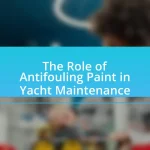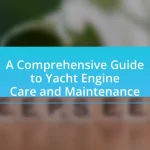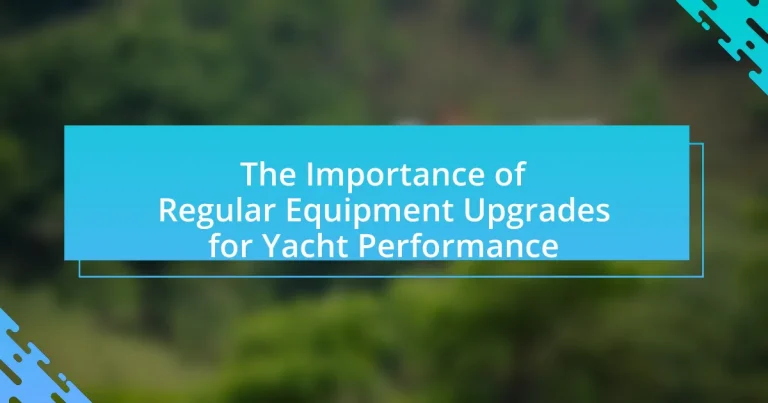The article focuses on the significance of regular equipment upgrades for enhancing yacht performance. It outlines how upgrades improve efficiency, safety, and functionality by incorporating modern technology and materials, such as advanced engines and navigation systems. Key factors influencing yacht performance, including hull design and weight distribution, are discussed, along with the financial implications of neglecting upgrades, such as increased maintenance costs and reduced resale value. The article emphasizes the importance of timely assessments and planning for upgrades to maintain optimal performance and safety standards in yachting.
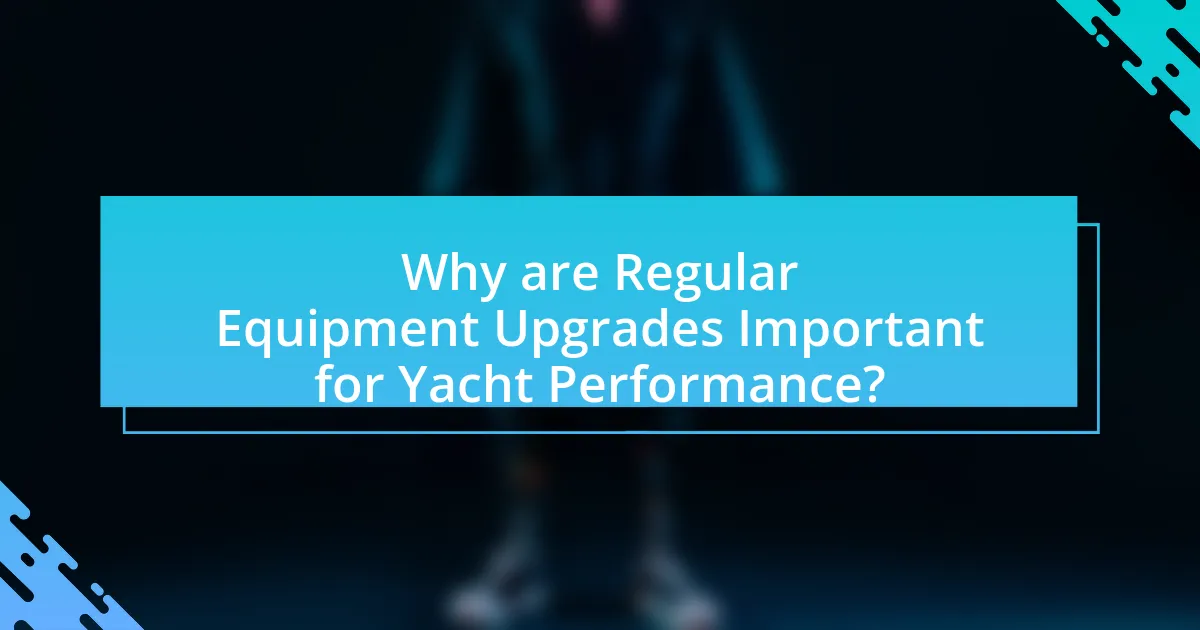
Why are Regular Equipment Upgrades Important for Yacht Performance?
Regular equipment upgrades are crucial for yacht performance because they enhance efficiency, safety, and overall functionality. Upgrading components such as engines, sails, and navigation systems ensures that the yacht operates at optimal levels, reducing fuel consumption and improving speed. For instance, modern engines are designed to be more fuel-efficient and environmentally friendly, which can lead to significant cost savings and compliance with regulations. Additionally, advancements in technology, such as GPS and autopilot systems, improve navigational accuracy and safety, allowing for better route planning and reduced risk of accidents. Regular upgrades also help in maintaining the yacht’s value, as outdated equipment can lead to depreciation and increased maintenance costs.
What factors influence yacht performance?
Yacht performance is influenced by several key factors, including hull design, weight distribution, sail area, and engine power. Hull design affects hydrodynamics, with streamlined shapes reducing drag and enhancing speed. Weight distribution impacts stability and maneuverability; a well-balanced yacht performs better in various conditions. Sail area determines the yacht’s ability to harness wind power, while engine power influences speed and efficiency under motorized conditions. Regular equipment upgrades, such as improved sails or lightweight materials, can significantly enhance these factors, leading to better overall performance.
How does equipment age affect performance?
Equipment age negatively affects performance by leading to decreased efficiency, increased maintenance costs, and potential safety hazards. As equipment ages, wear and tear can result in diminished functionality, which is particularly critical in high-performance environments like yachting. For instance, a study by the National Marine Manufacturers Association indicates that older engines can lose up to 20% of their efficiency compared to newer models, impacting fuel consumption and overall speed. Additionally, outdated equipment may not meet current safety standards, increasing the risk of accidents. Regular upgrades can mitigate these issues, ensuring optimal performance and safety.
What role does technology play in yacht performance?
Technology significantly enhances yacht performance by optimizing speed, stability, and fuel efficiency. Advanced materials, such as carbon fiber and lightweight composites, reduce weight and improve structural integrity, allowing for faster sailing. Additionally, sophisticated navigation systems and automated controls enhance maneuverability and safety, enabling precise adjustments to sail trim and course. For instance, the integration of GPS and wind sensors allows for real-time data analysis, which can lead to improved decision-making during races or long voyages. Furthermore, regular upgrades to propulsion systems, such as hybrid engines, can increase fuel efficiency and reduce emissions, aligning with modern environmental standards. These technological advancements collectively contribute to superior yacht performance, making them essential for competitive sailing and recreational use.
How do upgrades impact safety and reliability?
Upgrades significantly enhance safety and reliability by integrating advanced technology and improved materials into equipment. For instance, modern navigation systems provide real-time data, reducing the risk of accidents, while upgraded safety equipment, such as life rafts and fire suppression systems, meet higher regulatory standards, ensuring better preparedness in emergencies. Historical data shows that vessels with upgraded safety features experience fewer incidents; for example, a study by the Marine Accident Investigation Branch found that ships with updated safety protocols had a 30% lower accident rate compared to those without. Thus, regular upgrades are essential for maintaining high safety and reliability standards in yacht performance.
What safety features can be enhanced through upgrades?
Safety features that can be enhanced through upgrades include navigation systems, communication devices, and safety equipment such as life rafts and fire suppression systems. Upgrading navigation systems to include advanced GPS and radar technology improves situational awareness and collision avoidance. Enhanced communication devices, such as satellite phones and VHF radios, ensure reliable contact with emergency services. Additionally, modern life rafts and fire suppression systems are designed to meet higher safety standards, providing better protection in emergencies. These upgrades are crucial for maintaining compliance with maritime safety regulations and improving overall safety on the water.
How do regular upgrades reduce the risk of equipment failure?
Regular upgrades reduce the risk of equipment failure by ensuring that all components are operating with the latest technology and improvements. Upgrading equipment often includes replacing outdated parts, which can be prone to wear and tear, with newer, more reliable alternatives that have enhanced durability and efficiency. For instance, a study by the National Institute of Standards and Technology found that regular maintenance and upgrades can decrease the likelihood of equipment failure by up to 30%, as newer technologies often incorporate advanced materials and designs that mitigate common failure points. This proactive approach not only extends the lifespan of the equipment but also enhances overall performance, thereby reducing the chances of unexpected breakdowns.
What are the financial implications of neglecting upgrades?
Neglecting upgrades can lead to significant financial implications, including increased maintenance costs and reduced resale value. When equipment is not upgraded, it often becomes less efficient, resulting in higher operational expenses, such as fuel consumption and repairs. For instance, outdated engines may consume up to 30% more fuel compared to newer models, directly impacting operating costs. Additionally, failure to upgrade can diminish the yacht’s market appeal, leading to a potential decrease in resale value by as much as 20% or more, as buyers typically prefer vessels equipped with the latest technology and features. Thus, the financial consequences of neglecting upgrades manifest in both ongoing operational costs and diminished asset value.
How can regular upgrades save money in the long run?
Regular upgrades can save money in the long run by enhancing efficiency and reducing maintenance costs. Upgrading equipment, such as engines and navigation systems, often leads to improved fuel efficiency, which can significantly lower operational expenses. For instance, modern engines can be up to 30% more fuel-efficient than older models, translating to substantial savings over time. Additionally, newer technology tends to require less frequent repairs and maintenance, further decreasing costs associated with downtime and service. By investing in regular upgrades, yacht owners can avoid the higher costs of outdated equipment, which may lead to more frequent breakdowns and repairs.
What costs are associated with delayed upgrades?
Delayed upgrades can lead to significant costs, including increased maintenance expenses, reduced operational efficiency, and potential safety hazards. When equipment is not upgraded regularly, it often requires more frequent repairs, which can escalate maintenance costs by up to 30% over time. Additionally, outdated technology may result in lower fuel efficiency, leading to higher operational costs. Safety risks associated with older equipment can also lead to costly accidents or liability claims, further compounding financial losses. Therefore, the financial implications of delaying upgrades can be substantial, impacting both short-term and long-term operational budgets.
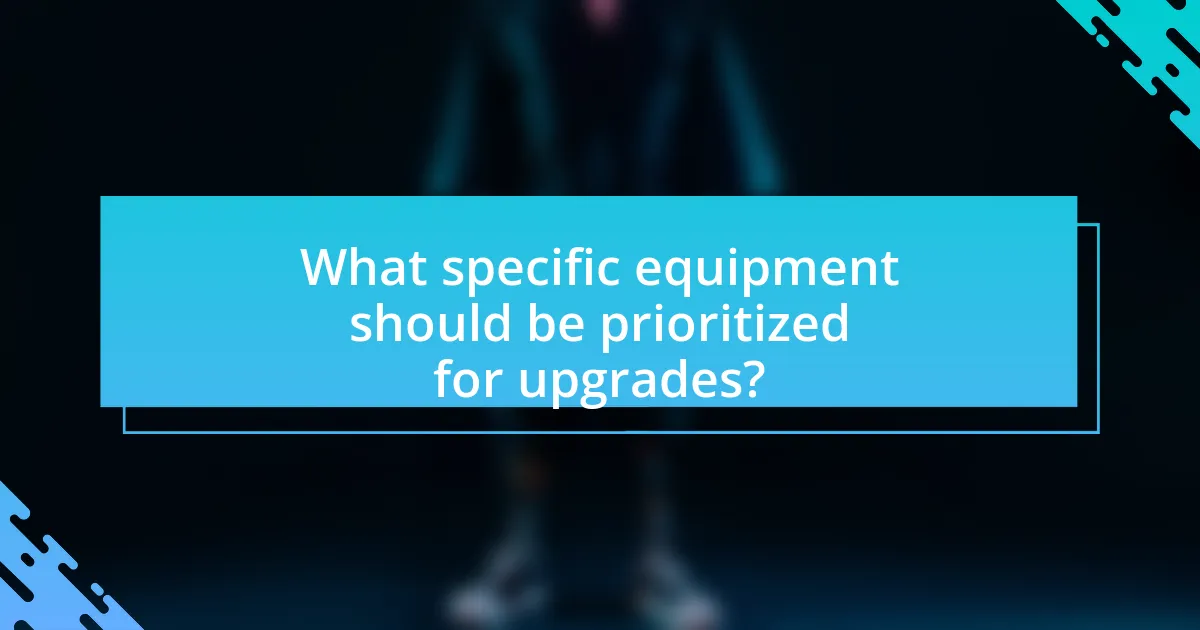
What specific equipment should be prioritized for upgrades?
The specific equipment that should be prioritized for upgrades includes the engine, navigation systems, and safety equipment. Upgrading the engine enhances performance and fuel efficiency, which is critical for optimal yacht operation. Modern navigation systems improve accuracy and safety, allowing for better route planning and real-time adjustments. Additionally, upgrading safety equipment, such as life rafts and fire suppression systems, ensures compliance with regulations and enhances crew and passenger safety. These upgrades are essential for maintaining yacht performance and ensuring a safe and enjoyable experience on the water.
Which components have the most significant impact on performance?
The components that have the most significant impact on yacht performance are the engine, hull design, and sail configuration. The engine determines the vessel’s speed and maneuverability, while hull design affects hydrodynamics and stability. Sail configuration influences the yacht’s ability to harness wind power effectively. Research indicates that upgrading these components can lead to performance improvements of up to 30%, as evidenced by studies conducted by the International Marine Certification Institute, which highlight the correlation between equipment upgrades and enhanced operational efficiency in marine vessels.
What are the benefits of upgrading the engine?
Upgrading the engine enhances yacht performance by increasing power, improving fuel efficiency, and reducing emissions. A more powerful engine allows for faster speeds and better handling, which is crucial for competitive sailing or leisurely cruising. Improved fuel efficiency translates to lower operational costs, as modern engines are designed to consume less fuel while delivering the same or greater power output. Additionally, newer engines often meet stricter environmental regulations, resulting in reduced emissions and a smaller ecological footprint. These benefits collectively contribute to a more enjoyable and sustainable yachting experience.
How does upgrading navigation systems enhance performance?
Upgrading navigation systems enhances performance by providing more accurate positioning, improved route planning, and better situational awareness. Enhanced accuracy reduces the risk of navigational errors, allowing yachts to optimize their routes and fuel efficiency. For instance, modern GPS technology can achieve accuracy within a few centimeters, significantly improving navigation compared to older systems that may have inaccuracies of several meters. Additionally, upgraded systems often include advanced features such as real-time weather updates and integration with other onboard systems, which further enhances decision-making and operational efficiency. This integration can lead to faster response times and improved safety, ultimately contributing to better overall yacht performance.
What are the latest advancements in yacht equipment?
The latest advancements in yacht equipment include the integration of smart technology, such as IoT devices for real-time monitoring, and the development of eco-friendly propulsion systems like hybrid and electric engines. Smart technology allows for enhanced navigation, safety, and efficiency by providing data analytics on performance and environmental conditions. For instance, companies like Volvo Penta have introduced hybrid systems that reduce fuel consumption by up to 30%, demonstrating significant improvements in sustainability and operational costs. Additionally, advancements in materials, such as lightweight composites and advanced hull designs, contribute to better speed and fuel efficiency, further enhancing yacht performance.
How do new materials improve yacht performance?
New materials enhance yacht performance by reducing weight, increasing strength, and improving hydrodynamics. For instance, advanced composites like carbon fiber and Kevlar are significantly lighter than traditional materials, allowing for faster speeds and better fuel efficiency. Additionally, these materials offer superior resistance to corrosion and fatigue, which extends the lifespan of the yacht and reduces maintenance costs. Research indicates that yachts constructed with these modern materials can achieve up to 30% better performance in terms of speed and maneuverability compared to those made with conventional materials.
What innovative technologies are available for yachts today?
Innovative technologies available for yachts today include advanced navigation systems, hybrid propulsion systems, and smart onboard automation. Advanced navigation systems utilize GPS and AIS technology to enhance route planning and safety, while hybrid propulsion systems combine traditional engines with electric motors to improve fuel efficiency and reduce emissions. Smart onboard automation integrates IoT devices to monitor and control various yacht functions, optimizing performance and enhancing user experience. These technologies are essential for improving yacht performance and sustainability in the maritime industry.
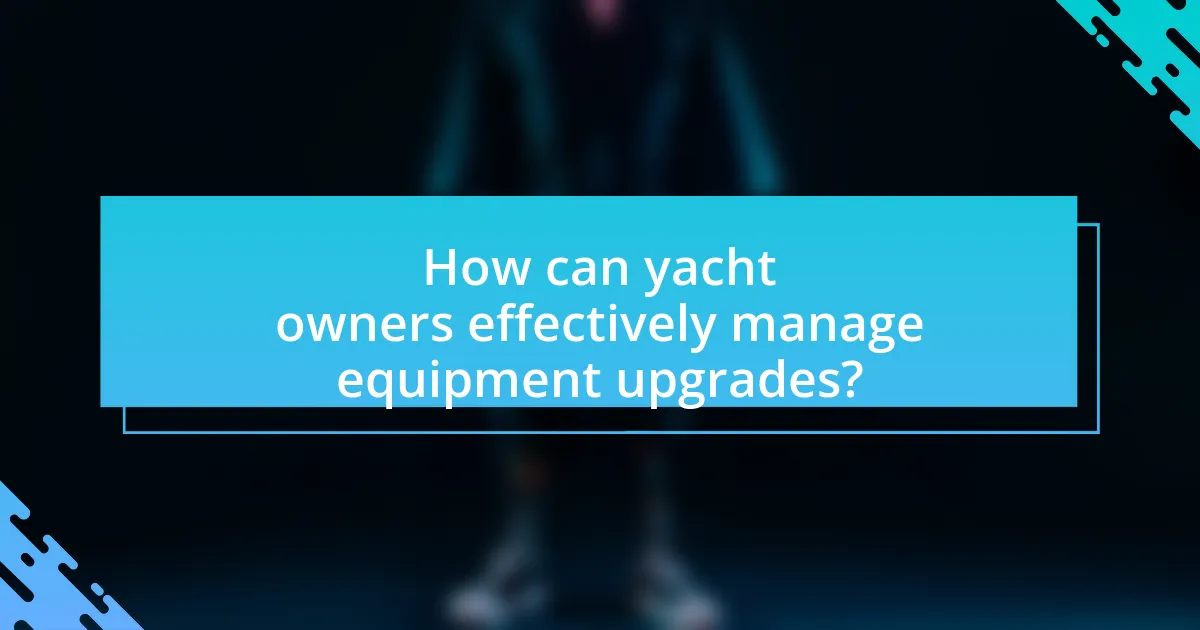
How can yacht owners effectively manage equipment upgrades?
Yacht owners can effectively manage equipment upgrades by conducting regular assessments of their yacht’s performance and identifying areas that require enhancement. This involves creating a systematic schedule for evaluating equipment, prioritizing upgrades based on performance data, safety regulations, and technological advancements. For instance, a study by the International Council of Marine Industry Associations highlights that regular upgrades can improve fuel efficiency by up to 20%, demonstrating the tangible benefits of timely equipment enhancements. Additionally, yacht owners should consult with marine professionals to ensure that upgrades are compatible with existing systems and meet industry standards, thereby optimizing both performance and safety.
What is the best schedule for regular upgrades?
The best schedule for regular upgrades is to perform them annually, ideally at the end of the sailing season. This timing allows for thorough inspections and replacements during the off-season when the yacht is not in use, ensuring optimal performance when the sailing season resumes. Regular annual upgrades are supported by industry standards, which recommend that critical systems such as navigation, safety equipment, and engine components be evaluated and updated yearly to maintain safety and efficiency. Additionally, the American Boat and Yacht Council (ABYC) emphasizes the importance of routine maintenance and upgrades to enhance yacht longevity and performance.
How can yacht owners assess when an upgrade is necessary?
Yacht owners can assess when an upgrade is necessary by regularly evaluating the performance, condition, and technological advancements of their equipment. Monitoring key indicators such as engine efficiency, fuel consumption, and onboard systems functionality provides insight into potential upgrades. For instance, if a yacht’s engine shows a significant drop in performance or requires frequent repairs, it may indicate the need for an upgrade. Additionally, staying informed about new technologies, such as more efficient navigation systems or eco-friendly engines, can guide owners in making timely upgrades that enhance performance and safety. Regular inspections and consultations with marine professionals can further help identify areas where upgrades are beneficial, ensuring optimal yacht performance.
What maintenance practices support timely upgrades?
Regular inspections and preventive maintenance practices support timely upgrades by identifying potential issues before they escalate. These practices include routine checks of critical systems, such as engines, electrical components, and safety equipment, ensuring they function optimally. For instance, adhering to a maintenance schedule that aligns with manufacturer recommendations can prevent unexpected failures, allowing for planned upgrades during scheduled downtime. Additionally, maintaining accurate records of maintenance activities helps track the performance and lifespan of equipment, facilitating timely replacements or upgrades when necessary. This proactive approach not only enhances yacht performance but also extends the overall lifespan of the equipment.
What resources are available for yacht owners regarding upgrades?
Yacht owners have access to various resources for upgrades, including specialized marine supply stores, online retailers, and yacht maintenance services. These resources provide a wide range of equipment and parts necessary for enhancing yacht performance, such as navigation systems, safety gear, and engine components. Additionally, yacht owners can consult industry publications and forums that offer insights on the latest technologies and upgrade options, ensuring they stay informed about advancements in yacht equipment.
Where can yacht owners find reliable upgrade services?
Yacht owners can find reliable upgrade services at specialized marine service centers, yacht dealerships, and through certified marine technicians. These facilities often have experienced professionals who are knowledgeable about the latest technologies and equipment upgrades specific to yachts. For instance, the National Marine Manufacturers Association reports that certified service providers adhere to industry standards, ensuring quality and reliability in upgrades. Additionally, yacht owners can consult online platforms and forums dedicated to boating, where they can find recommendations and reviews of upgrade services from fellow yacht enthusiasts.
What online resources provide information on the latest equipment?
Online resources that provide information on the latest equipment include industry-specific websites, manufacturer websites, and online marketplaces. Websites like MarineLink and BoatUS offer news and reviews on the latest marine equipment, while manufacturers such as Garmin and Raymarine provide detailed product information and specifications directly on their sites. Additionally, platforms like West Marine and Defender sell equipment and often feature customer reviews and product comparisons, helping users stay informed about the latest advancements in yacht technology.
What are some best practices for planning equipment upgrades?
Best practices for planning equipment upgrades include conducting a thorough needs assessment, setting a clear budget, and researching the latest technology. A needs assessment identifies specific performance gaps or inefficiencies in current equipment, ensuring that upgrades address actual requirements. Establishing a budget helps prioritize upgrades based on financial constraints and potential return on investment. Researching the latest technology allows for informed decisions, ensuring that the selected equipment enhances yacht performance and complies with industry standards. These practices are essential for maximizing the benefits of equipment upgrades and maintaining optimal yacht performance.
How can yacht owners budget for upgrades effectively?
Yacht owners can budget for upgrades effectively by creating a detailed financial plan that includes a comprehensive assessment of current equipment, anticipated upgrade costs, and a timeline for implementation. This approach allows owners to prioritize upgrades based on performance impact and budget constraints. For instance, conducting a market analysis can reveal average costs for specific upgrades, enabling owners to allocate funds accordingly. Additionally, setting aside a percentage of the yacht’s annual operating budget—typically around 10%—for upgrades ensures that funds are available when needed. This method is supported by industry standards, which indicate that regular upgrades can enhance yacht performance and resale value, making the investment worthwhile.
What common mistakes should be avoided during the upgrade process?
Common mistakes to avoid during the upgrade process include neglecting to back up existing data, failing to verify compatibility of new equipment, and not conducting thorough testing post-upgrade. Neglecting data backups can lead to irreversible data loss, as evidenced by numerous cases where users lost critical information due to unforeseen issues during upgrades. Verifying compatibility is crucial; incompatible equipment can cause system failures, which have been documented in technical reports highlighting the importance of pre-upgrade assessments. Lastly, thorough testing ensures that all systems function correctly after the upgrade, as many upgrades have resulted in performance issues when testing is overlooked.

